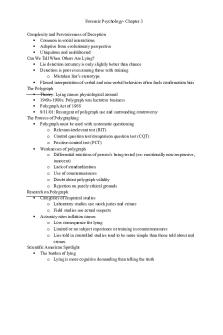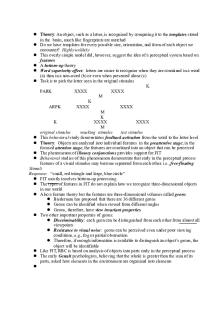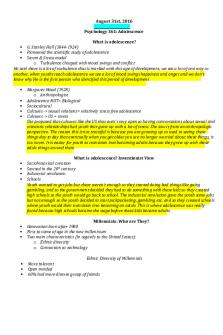Psychology 210-chapter 3 quiz-review PDF

| Title | Psychology 210-chapter 3 quiz-review |
|---|---|
| Course | Developmental Psychology |
| Institution | Liberty University |
| Pages | 8 |
| File Size | 107.1 KB |
| File Type | |
| Total Downloads | 45 |
| Total Views | 164 |
Summary
chapter 3 complete quiz...
Description
Psychology 210: Developmental Psychology Professor Jennifer Kennedy Spring 2022/ Chapter 3 Review
Key Ideas
The most rapid and dramatic development that occurs throughout the lifespan takes place within the woman’s uterus.
Pregnancy is dated from a woman’s last menstrual period before conception, which makes the normal gestational period 280 days long.
At birth, women have one million undeveloped ova. During her child-bearing years an average woman will produce about 300 mature eggs.
A typical male will produce up to 500 billion sperm over the course of his lifetime. A single ejaculate could contain as many as 150 million sperm.
Prenatal development is divided into three periods: the period of the zygote, the embryonic period, and the fetal period.
The period of the zygote lasts from fertilization until implantation.
The period of the embryo lasts from implantation through the eighth week of pregnancy.
The period of the fetus is the longest period, lasting from the ninth week until birth.
Amniocenteses are typically performed on the mother between 14 and 16 weeks after conception.
Chorionic villus sampling is performed earlier in the pregnancy, typically between the 9th and 12th weeks after conception.
The most common type of prenatal assessment is the ultrasound.
Defining Terms 1.) Define the following basic terms: stem cells, placenta, and amniocentesis.
is a plate-like mass of cells that permits food and oxygen to reach the developing embryo and carries away waste products back to the mother. (placenta)
are cells that have the potential to form any specialized structure in the body. (Stem cells)
is a procedure performed on the mother between 14-16 weeks after conception in which a needle is used to withdraw fluid from the amniotic sac for testing. It is more commonly done among women who become pregnant after the age of 35. (amniocentesis)
2.) What is the difference between an ultrasound and a sonogram? A(n) is the most-used type of prenatal assessment. It is the process by which a health care professional uses high frequency sound waves to obtain information about the developing fetus. These waves are reflected by the fetus and a computer uses the information to generate pictures of the fetus. A(n) is the picture of the fetus generated by an ultrasound. (Ultrasound, sonogram) Multiple Choice 1. The three prenatal developmental periods are the period of the _________, the _________ period, and the _________ period.
A. Gamete, fetal, baby
B. Embryonic, prenatal, neonatal,
C. Zygote, embryonic, fetal
D. Zygote, fetal, postnatal
2. The placenta is connected to the embryo by the _________. This can grow to 1-3 feet in length. Its one large vein delivers _________ _________ and its two large arteries remove _________ _________.
A. Uterus; waste products; nutrient-rich blood,
B. Umbilical cord; nutrient-rich blood; waste products
C. Amnion, food; waste products
D. Umbilical cord; waste products; nutrient-rich blood
3. The _________ is the point at which a baby can survive life outside the womb. It occurs between weeks _________.
A. age of viability; 22-26
B. age of sustainability; 23-30
C. age of life expectancy; 24-25
D. age of external ability; 20-24
4. All the following are responsibilities of amniotic fluid except:
A. Temperature regulation in the womb
B. Cushioning the fetus against any jolts caused by the mother’s movements
C. Produce blood cells until the fetus’s own organs can produce blood cells
D. Stimulating the fetus’ skeletal growth
Key Ideas During the development of the fetus, there are a variety of factors that contribute to the well-being of the child.
The extent to which a developing embryo or fetus is impacted by a teratogen is determined by both the timing of the exposure and the quantity of the teratogen to which the embryo or fetus is exposed.
Multiple Choice:
1. Which of the following domains are imperative for women to consider during pregnancy?
A. Maternal diet, including weight
B. Maternal well-being, including anxiety, fear, and depression
C. Maternal age, particularly adolescent mothers, and those over age 35
D. All are imperative domains to consider
2. _________ is a collection of cognitive, behavioral, physical and social deficits and abnormalities that appear among children who were exposed to alcohol in the womb. Approximately 1 in every _________ children are born with FASD annually, and it is one of the leading causes of _________ .
A. Fetal Alcohol Spectrum Disorder; 1,000; birth defects
B. Teratogens; 10,000; birth disabilities
C. Fetal Alcohol Syndrome; 1,000; developmental disabilities
D. Fetal Alcohol Spectrum Disorder; 10,000; birth defects
3. Quitting _________ is just as important for the health of the developing embryo as is quitting _________.
A. Illicit drugs; poor eating habits
B. Prescription drugs; smoking
C. Smoking; illicit drugs
D. Smoking; prescription drugs
Key Ideas There are three stages to the birth process: (1) dilation and effacement of the cervix, (2) delivery of the baby, and (3) delivery of the placenta.
There are many approaches to childbirth, including various options for where and how the mother will have the baby.
The use of medical interventions has reached an all-time high because of multiple births and other highrisk deliveries, which have increased with the ages of mothers.
There are two different types of fetal monitors that are used during labor: internal and external.
Inadequate oxygen, a pregnancy that ends too early, and being born underweight all pose serious health risks to a child.
Basic Defining: Click on the blanks to reveal answer!
Define the following key terms: Braxton-Hicks, kangaroo care, and low birth weight.
The first uterine contracts which are indicative of false labor are called .
is the process in which a baby is placed skin to skin and chest to chest with a parent.
A baby is considered to have when it weighs less than 5.5 (~2500 grams).
Explain the difference between dilation and effacement of the cervix.
is the opening of the cervix and is the thinning out of the cervix. Both are part of stage 1 of labor and both must happen to prepare for and allow the baby to pass through the uterus, to the birth canal and out of the vagina.
Multiple Choice:
1. Labor and delivery is described in three stages. Which of the following is not one of the three stages?
A. Delivery of the baby
B. Braxton-Hicks
C. Dilation and Effacement of the cervix.
D. Delivery of the placenta
2. In a typical natural (or prepared) childbirth program, the mother and a companion will participate in which three activities?
A. Take classes; be mentored by another mother; work with a labor coach
B. Work with a labor coach; read a birthing book; learn relaxation and breathing techniques
C. learn relaxation and breathing techniques; take classes; tour a birthing center
D. Work with a labor coach; take classes; learn relaxation and breathing techniques
3. Some women must, or opt to, experience _________, which is the process of artificially starting labor, usually by breaking the amnion (bag of water) and administering a synthetic oxytocin to stimulate contractions. Similarly, some women must, or opt to, experience a _________, which is a surgical procedure in which the baby is removed from the uterus through an incision made in the mother’s abdomen. A. C-section; amniocentesis
B. Natural childbirth; cesarean delivery
C. Induced labor; cesarean delivery
D. Pre-term cesarean; induced labor
4. Two types of oxygen deprivation can occur during pregnancy, labor, and/or delivery: _________, when the fetus has not received enough oxygen while in utero to develop properly, and _________, the absence of oxygen.
A. Anoxia; hypoxia
B. Hypoxia; anoxia
C. Hypoxemia; anoxia
D. Anoxia; suffocation...
Similar Free PDFs

Forensic Psychology Chapter 3
- 3 Pages

3 Positive Psychology Tools
- 20 Pages

Psychology Chapter 3 Notes
- 4 Pages

Psychology Unit 3 AOS1
- 8 Pages

Psychology 101 - Exam 3
- 4 Pages

Chapter 3 Psychology
- 8 Pages

3. Adler Individual Psychology
- 8 Pages

Psychology unit 3 discussion
- 2 Pages

Psychology Notes- chapter 3
- 3 Pages

Abnormal Psychology Chapter 3
- 9 Pages

Cognitive Psychology Paper 3
- 5 Pages

Cognitive psychology 3
- 3 Pages

Psychology 361 Notes 1-3
- 19 Pages

Psychology UNIT 3/4 Notes
- 115 Pages

Unit 3 Psychology Test Review
- 5 Pages
Popular Institutions
- Tinajero National High School - Annex
- Politeknik Caltex Riau
- Yokohama City University
- SGT University
- University of Al-Qadisiyah
- Divine Word College of Vigan
- Techniek College Rotterdam
- Universidade de Santiago
- Universiti Teknologi MARA Cawangan Johor Kampus Pasir Gudang
- Poltekkes Kemenkes Yogyakarta
- Baguio City National High School
- Colegio san marcos
- preparatoria uno
- Centro de Bachillerato Tecnológico Industrial y de Servicios No. 107
- Dalian Maritime University
- Quang Trung Secondary School
- Colegio Tecnológico en Informática
- Corporación Regional de Educación Superior
- Grupo CEDVA
- Dar Al Uloom University
- Centro de Estudios Preuniversitarios de la Universidad Nacional de Ingeniería
- 上智大学
- Aakash International School, Nuna Majara
- San Felipe Neri Catholic School
- Kang Chiao International School - New Taipei City
- Misamis Occidental National High School
- Institución Educativa Escuela Normal Juan Ladrilleros
- Kolehiyo ng Pantukan
- Batanes State College
- Instituto Continental
- Sekolah Menengah Kejuruan Kesehatan Kaltara (Tarakan)
- Colegio de La Inmaculada Concepcion - Cebu
